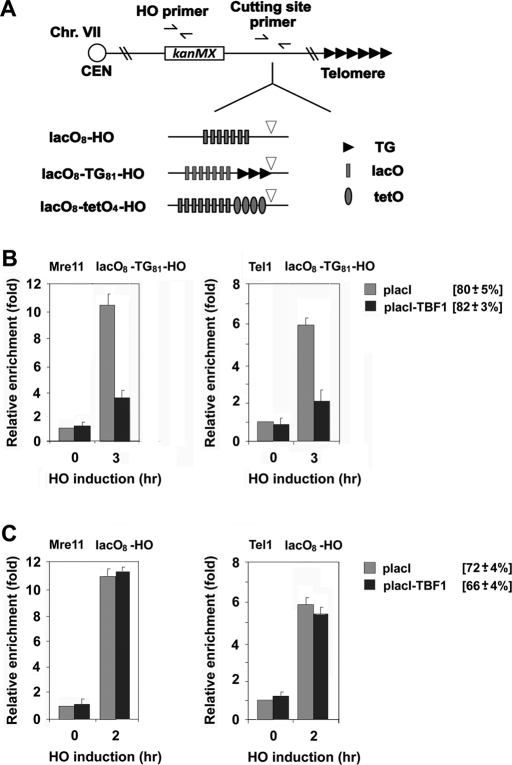FIGURE 4:
Effect of Tbf1 or Rap1 tethering on MRX association with nearby DNA ends. (A) Schematic of the HO cleavage site, the LacO8 array, the TetO4 array, or the TG81 repeat at the ADH4 locus on chromosome VII-L. In LacO8-TG81-HO or LacO8-HO cells, eight copies of the lacO sequence (gray rectangle) were placed centromere-proximal to the TG81-HO cassette or the HO cleavage site, respectively. In LacO8-TetO4-HO cells, eight copies of the lacO sequence and four copies of the tetO sequence (barrel) were placed centromere-proximal to the HO cleavage site. Centromere is shown as a circle on the left (CEN). The HO primer pair was designed to amplify a region 1 kbp away from the HO site, and the cutting-site primer pair was used to determine the HO cutting efficiency. (B) Effect of Tbf1 tethering on association of Mre11 or Tel1 with nearby TG81 ends. LacO8-TG81-HO (KSC2861) cells expressing Mre11-myc and Tel1-HA were transformed with placI-TBF1 or the control vector, together with the GAL-HO plasmid. Cells were analyzed by ChIP assay as in Figure 1B to monitor accumulation of Mre11 or Tel1 at DNA ends. (C) Effect of Tbf1 tethering on association of Mre11 or Tel1 with nearby HO ends. LacO8-HO (KSC2862) cells expressing Mre11-myc and Tel1-HA were transformed with placI-TBF1 or the control vector, together with the GAL-HO plasmid. Cells were analyzed by ChIP assay as in B to monitor accumulation of Mre11 or Tel1 at DNA ends.

